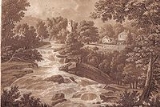
Bonnington Pavilion
Encyclopedia
The Bonnington Pavilion or Hall of Mirrors, now a ruin, is situated in the grounds of the old estate of Bonnington, near New Lanark
, overlooking Corra Linn falls
on the River Clyde
in Lanarkshire
, Scotland
. Alternative names are the Corra Linn Pavilion and the Falls of Clyde summerhouse. The name comes from the Gaelic 'currach', a marshy place. A legend gives 'Cora' as a daughter of King Malcolm II
, who leapt to her death here whilst trying to escape imagined danger.
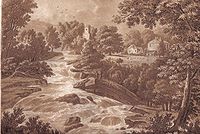
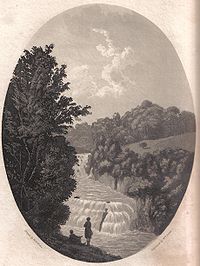 The building is dated 1708 over the entrance and was constructed by Sir James Carmichael of Bonnington House for the entertainment of his friends and guests. The building had mirrors installed which gave a view of the Falls of Clyde. A view of Corra Linn in 1799 – 1800 taken from Stoddarts Remarks on Scottish scenery gives some idea of the view that visitors would have seen in the 18th-century.
The building is dated 1708 over the entrance and was constructed by Sir James Carmichael of Bonnington House for the entertainment of his friends and guests. The building had mirrors installed which gave a view of the Falls of Clyde. A view of Corra Linn in 1799 – 1800 taken from Stoddarts Remarks on Scottish scenery gives some idea of the view that visitors would have seen in the 18th-century.
At the time of the construction of the pavilion it was generally felt amongst the aristocracy that nature was cruel and ugly and that women of good breeding should not look upon it unless it was reflected in a mirror or seen through a frame, thereby detaching the view from the aspect of harsh reality and transferring it to that of good taste and high art.
The building was still in use in the early 19th century, although Stoddart refers to it as a summerhouse. Garnett on his 1800 tour refers to the building as a 'pavilion' and mentions the mirrors, saying that .. as at Dunkeld, mirrors are placed, by the reflection of which we had different views of the water. He also comments on the fine view of the cotton mills that was to be had from the west window. It is not clear when it was abandoned. The New Lanark
Trust are trying to secure an agreement from Scottish Power
to allow them to restore the building.
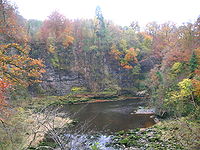
 The pavilion had 2 floors, and the bottom floor may have been used at one stage as a kitchen for the preparation of refreshments for the ladies and gentlemen who came down from Bonnington House to view the falls.
The pavilion had 2 floors, and the bottom floor may have been used at one stage as a kitchen for the preparation of refreshments for the ladies and gentlemen who came down from Bonnington House to view the falls.
A relatively large window, probably originally having shutters either side, looks onto the falls. The entrance door has a window set on each side, which would have prevented the projection of an image onto mirrors placed onto this 'back' wall. A window and ground floor door were present in each of the two side walls of the building; providing up to three doors altogether into the ground floor and a total of five windows, providing for exceptionally good views out of the building. The only apparently uninterrupted surface was the upper ceiling. The artist Alexander Archer sketched the pavilion, probably including some 'artistic licence' from the south-west in 1837. This sketch shows a different arrangement of the steps leading up to the door and a stone gable end, with highly ornate 'crow step' ornamentation, which would have given the building a typical arched sloping roof rather than a flat one as suggested by the remains today (2007). It may well be that the changes to the entrance steps took place when the hydroelectric power station was constructed in 1926 as the pipes carrying the water to the turbine house run very close to the pavilion entrance and they had to be moved to run parallel to the front of the building.
The building shows signs of other alterations, such as the closing up of one of the lower ground front 'servants' entrance to the suggested kitchen area and the provision of a balustrade at the viewing window, suggesting that at a later date the method of use of the building changed. Some modern repairs have been carried out to stabilise the building as indicated by recent pointing work, new wood lintels, etc.
Swan records that A beautiful though more distant view of this extraordinary scene, may be had from the window of a pavilion, erected by Sir James Carmichael of Bonniton, placed far above, on the very summit of the sloping bank which rises from the perpendicular rocks, can contemplate the whole freed from those feelings of terror with which in nearer situations, he cannot fail to be visited. Indeed, the scene has here more of the effect of a picture, or a beautiful panoramic view; the trees through which it is seen adding their interest to the foreground, or forming as it were a framework at the sides. At the opposite end of the pavilion, a Mirror is placed, in which this rich landscape is reflected; and from its position, the spectator is almost led to believe that the cataract is tumbling upon his head. Unfortunately, however, the illusion is not made so perfect as it might obviously be. The Mirror is neither of sufficient size, of a proper shape, or sufficiently concealed in the wall. Were a little expense laid out on the pavilion, which appears to be exactly as it was left by Sir John, a hundred and twenty years ago, the illusion might be exceedingly striking.
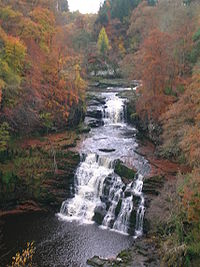
viewpoint records that J. M. W. Turner, Sir Walter Scott, Samuel Taylor Coleridge
and his friend William Wordsworth
all visited. Turner produced a painting of the falls and Wordworth immortalised Corra Linn in verse in 1802. We cannot be sure that they visited the pavilion, but it is not unlikely, given the presence of a guide at Bonnington House lodge.
The Oxford educated cleric Rev. William Gilpin (1724–1804), a schoolmaster in Surrey, toured Britain and visited the Falls of Clyde. He built an enormously influential theory on this convergence of travel and artistic recreation. John Stoddart relates that when he visited in 1799 - 1800 the mansion house of Bonnyton (Bonnington) was the seat of Lady Ross. He commends her for permitting unrestricted access to the falls and states that a porter was based at the Bonnyton Lodge house who would escorted visitor to the best viewing points and to the 'summer-house' as he calls it. Most frustratingly he did not wish to be 'restrained' and failed to visit the actual pavilion itself.
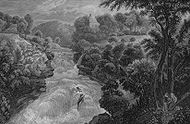 Wallace's Cave is a cavity in the face of the cliff near Corra Linn, nearly circular in form, 12 feet in height and about 10 feet in diameter. It is said to have been a hiding place of Wallace, however the late Mr G Ross remembered the cave being formed during the construction of a swing bridge. Stoddart mentions the 'Walalce's cove' in his records of his visit in 1799 - 1800.
Wallace's Cave is a cavity in the face of the cliff near Corra Linn, nearly circular in form, 12 feet in height and about 10 feet in diameter. It is said to have been a hiding place of Wallace, however the late Mr G Ross remembered the cave being formed during the construction of a swing bridge. Stoddart mentions the 'Walalce's cove' in his records of his visit in 1799 - 1800.
Corra Castle, Corrax Castle; Corehouse Castle ruins are situated on the other side of the Clyde at map reference: NS 8822 4141. It belongs to the period from 1572 to 1700. The site of the castle is a precipitous rock which, on three sides, overlooks the Clyde. On the fourth are the remains of a ditch which at its west end drops down into a chasm. The ruins comprise remains of a tower and a small courtyard.
Corehouse
is a large country house and estate on the opposite side of the Clyde.
New Lanark
New Lanark is a village on the River Clyde, approximately 1.4 miles from Lanark, in South Lanarkshire, Scotland. It was founded in 1786 by David Dale, who built cotton mills and housing for the mill workers. Dale built the mills there to take advantage of the water power provided by the river...
, overlooking Corra Linn falls
Falls of Clyde (waterfalls)
The Falls of Clyde is the collective name of four linn on the River Clyde near New Lanark, South Lanarkshire, Scotland. The Falls of Clyde comprise the upper falls of Bonnington Linn, Corra Linn, Dundaff Linn, and the lower falls of Stonebyres Linn. Corra Linn is the highest, with a fall of 90 feet...
on the River Clyde
River Clyde
The River Clyde is a major river in Scotland. It is the ninth longest river in the United Kingdom, and the third longest in Scotland. Flowing through the major city of Glasgow, it was an important river for shipbuilding and trade in the British Empire....
in Lanarkshire
Lanarkshire
Lanarkshire or the County of Lanark ) is a Lieutenancy area, registration county and former local government county in the central Lowlands of Scotland...
, Scotland
Scotland
Scotland is a country that is part of the United Kingdom. Occupying the northern third of the island of Great Britain, it shares a border with England to the south and is bounded by the North Sea to the east, the Atlantic Ocean to the north and west, and the North Channel and Irish Sea to the...
. Alternative names are the Corra Linn Pavilion and the Falls of Clyde summerhouse. The name comes from the Gaelic 'currach', a marshy place. A legend gives 'Cora' as a daughter of King Malcolm II
Malcolm II of Scotland
Máel Coluim mac Cináeda , was King of the Scots from 1005 until his death...
, who leapt to her death here whilst trying to escape imagined danger.
The history of the pavilion


At the time of the construction of the pavilion it was generally felt amongst the aristocracy that nature was cruel and ugly and that women of good breeding should not look upon it unless it was reflected in a mirror or seen through a frame, thereby detaching the view from the aspect of harsh reality and transferring it to that of good taste and high art.
The building was still in use in the early 19th century, although Stoddart refers to it as a summerhouse. Garnett on his 1800 tour refers to the building as a 'pavilion' and mentions the mirrors, saying that .. as at Dunkeld, mirrors are placed, by the reflection of which we had different views of the water. He also comments on the fine view of the cotton mills that was to be had from the west window. It is not clear when it was abandoned. The New Lanark
New Lanark
New Lanark is a village on the River Clyde, approximately 1.4 miles from Lanark, in South Lanarkshire, Scotland. It was founded in 1786 by David Dale, who built cotton mills and housing for the mill workers. Dale built the mills there to take advantage of the water power provided by the river...
Trust are trying to secure an agreement from Scottish Power
Scottish Power
ScottishPower Ltd. is a vertically integrated energy company with its headquarters in Glasgow, Scotland. It was listed on the London Stock Exchange and was once a constituent of the FTSE 100 Index but in 2006 it became a subsidiary of the Spanish utility Iberdrola...
to allow them to restore the building.
Design details of the pavilion


A relatively large window, probably originally having shutters either side, looks onto the falls. The entrance door has a window set on each side, which would have prevented the projection of an image onto mirrors placed onto this 'back' wall. A window and ground floor door were present in each of the two side walls of the building; providing up to three doors altogether into the ground floor and a total of five windows, providing for exceptionally good views out of the building. The only apparently uninterrupted surface was the upper ceiling. The artist Alexander Archer sketched the pavilion, probably including some 'artistic licence' from the south-west in 1837. This sketch shows a different arrangement of the steps leading up to the door and a stone gable end, with highly ornate 'crow step' ornamentation, which would have given the building a typical arched sloping roof rather than a flat one as suggested by the remains today (2007). It may well be that the changes to the entrance steps took place when the hydroelectric power station was constructed in 1926 as the pipes carrying the water to the turbine house run very close to the pavilion entrance and they had to be moved to run parallel to the front of the building.
The building shows signs of other alterations, such as the closing up of one of the lower ground front 'servants' entrance to the suggested kitchen area and the provision of a balustrade at the viewing window, suggesting that at a later date the method of use of the building changed. Some modern repairs have been carried out to stabilise the building as indicated by recent pointing work, new wood lintels, etc.
The purpose of the mirrors
The pavilion had mirrors which reflected the falls, giving visitors, who sat with their backs to the window, the illusion, once the shutters or 'doors' were thrown open, that they were standing in the middle of the waterfalls. The Pavilion, according to another report had mirrors on its back wall. When the doors were opened visitors supposedly had the illusion of standing beneath the falls.Swan records that A beautiful though more distant view of this extraordinary scene, may be had from the window of a pavilion, erected by Sir James Carmichael of Bonniton, placed far above, on the very summit of the sloping bank which rises from the perpendicular rocks, can contemplate the whole freed from those feelings of terror with which in nearer situations, he cannot fail to be visited. Indeed, the scene has here more of the effect of a picture, or a beautiful panoramic view; the trees through which it is seen adding their interest to the foreground, or forming as it were a framework at the sides. At the opposite end of the pavilion, a Mirror is placed, in which this rich landscape is reflected; and from its position, the spectator is almost led to believe that the cataract is tumbling upon his head. Unfortunately, however, the illusion is not made so perfect as it might obviously be. The Mirror is neither of sufficient size, of a proper shape, or sufficiently concealed in the wall. Were a little expense laid out on the pavilion, which appears to be exactly as it was left by Sir John, a hundred and twenty years ago, the illusion might be exceedingly striking.
Views of the Bonnington Pavilion

Famous visitors
The interpretation board at the Falls of Clyde (waterfalls)Falls of Clyde (waterfalls)
The Falls of Clyde is the collective name of four linn on the River Clyde near New Lanark, South Lanarkshire, Scotland. The Falls of Clyde comprise the upper falls of Bonnington Linn, Corra Linn, Dundaff Linn, and the lower falls of Stonebyres Linn. Corra Linn is the highest, with a fall of 90 feet...
viewpoint records that J. M. W. Turner, Sir Walter Scott, Samuel Taylor Coleridge
Samuel Taylor Coleridge
Samuel Taylor Coleridge was an English poet, Romantic, literary critic and philosopher who, with his friend William Wordsworth, was a founder of the Romantic Movement in England and a member of the Lake Poets. He is probably best known for his poems The Rime of the Ancient Mariner and Kubla...
and his friend William Wordsworth
William Wordsworth
William Wordsworth was a major English Romantic poet who, with Samuel Taylor Coleridge, helped to launch the Romantic Age in English literature with the 1798 joint publication Lyrical Ballads....
all visited. Turner produced a painting of the falls and Wordworth immortalised Corra Linn in verse in 1802. We cannot be sure that they visited the pavilion, but it is not unlikely, given the presence of a guide at Bonnington House lodge.
The Oxford educated cleric Rev. William Gilpin (1724–1804), a schoolmaster in Surrey, toured Britain and visited the Falls of Clyde. He built an enormously influential theory on this convergence of travel and artistic recreation. John Stoddart relates that when he visited in 1799 - 1800 the mansion house of Bonnyton (Bonnington) was the seat of Lady Ross. He commends her for permitting unrestricted access to the falls and states that a porter was based at the Bonnyton Lodge house who would escorted visitor to the best viewing points and to the 'summer-house' as he calls it. Most frustratingly he did not wish to be 'restrained' and failed to visit the actual pavilion itself.
Nearby points of interest

Corra Castle, Corrax Castle; Corehouse Castle ruins are situated on the other side of the Clyde at map reference: NS 8822 4141. It belongs to the period from 1572 to 1700. The site of the castle is a precipitous rock which, on three sides, overlooks the Clyde. On the fourth are the remains of a ditch which at its west end drops down into a chasm. The ruins comprise remains of a tower and a small courtyard.
Corehouse
Corehouse
Corehouse is a large country house and estate, located approximately 30 miles to the south east of Glasgow, Scotland. The estate is by the Corra Linn Falls on the River Clyde, and close to the World Heritage Site of New Lanark, in South Lanarkshire....
is a large country house and estate on the opposite side of the Clyde.

